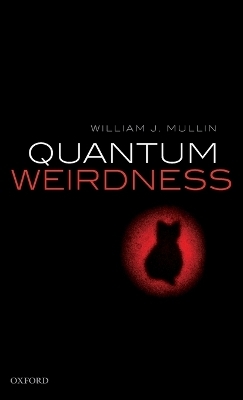
Quantum Weirdness
Oxford University Press (Verlag)
978-0-19-879513-1 (ISBN)
Quantum mechanics allows a remarkably accurate description of nature and powerful predictive capabilities. The analyses of quantum systems and their interpretation lead to many surprises, for example, the ability to detect the characteristics of an object without ever touching it in any way, via "interaction-free measurement," or the teleportation of an atomic state over large distances. The results can become downright bizarre.
Quantum mechanics is a subtle subject that usually involves complicated mathematics -- calculus, partial differential equations, etc., for complete understanding. Most texts for general audiences avoid all mathematics. The result is that the reader misses almost all deep understanding of the subject, much of which can be probed with just high-school level algebra and trigonometry. Thus, readers with that level of mathematics can learn so much more about this fundamental science.
The book starts with a discussion of the basic physics of waves (an appendix reviews some necessary classical physics concepts) and then introduces the fundamentals of quantum mechanics, including the wave function, superposition, entanglement, Bell's theorem, etc., and applications to Bose--Einstein condensation, quantum computing, and much more. The interpretation of the mathematics of quantum mechanics into a world view has been the subject of much controversy. The result is a variety of conflicting interpretations, from the famous Copenhagen view of Bohr to the multiple universes of Everett. We discuss these interpretations in the chapter "What is a wave function?" and include some very recent advances, for example, quantum Bayesianism, and measurements of the reality of the wave function.
William J. Mullin is Professor Emeritus at the University of Massachusetts. His areas of research are quantum fluids and solids and low temperature physics. Most recently, his research has focused on Bose--Einstein condensation and the fundamentals of quantum mechanics. Mullin has authored 100 journal publications and 3 books and has been a visiting scientist for extended periods at the University of Sussex, Royal Holloway, University of London, and the École normale supérieure, Paris.
1: Waves
2: Quantum Particles and Waves
3: Harmonic Oscillators
4: Superposition
5: Entanglement
6: The Mach--Zehnder Interferometer
7: Bell's Theorem and the Merman Machine
8: What Is a Wave Function?
9: Bose--Einstein Condensation and Superuidity
10: The Quantum Zeno Effect
11: Bosons and Fermions
12: The Quantum Eraser
13: Virtual Particles and the Four Forces
14: Teleportation of a Quantum State
15: Quantum Computing
16: Weird Measurements
Epilogue
| Erscheinungsdatum | 13.02.2017 |
|---|---|
| Zusatzinfo | 83 line figures and 3 half tones |
| Verlagsort | Oxford |
| Sprache | englisch |
| Maße | 147 x 222 mm |
| Gewicht | 430 g |
| Themenwelt | Sachbuch/Ratgeber ► Natur / Technik |
| Naturwissenschaften ► Physik / Astronomie ► Atom- / Kern- / Molekularphysik | |
| Naturwissenschaften ► Physik / Astronomie ► Hochenergiephysik / Teilchenphysik | |
| Naturwissenschaften ► Physik / Astronomie ► Quantenphysik | |
| ISBN-10 | 0-19-879513-0 / 0198795130 |
| ISBN-13 | 978-0-19-879513-1 / 9780198795131 |
| Zustand | Neuware |
| Haben Sie eine Frage zum Produkt? |
aus dem Bereich


